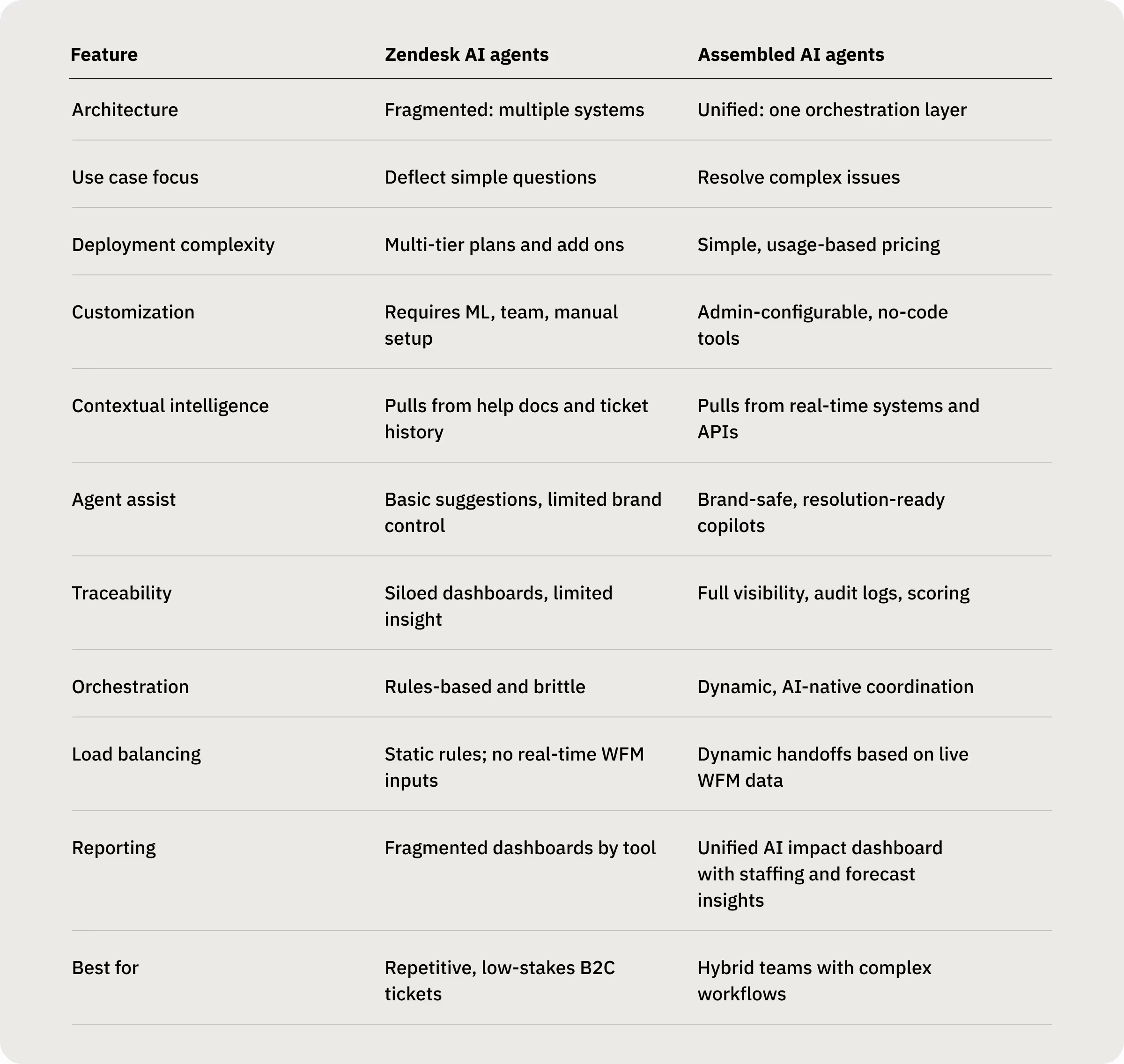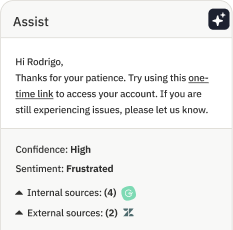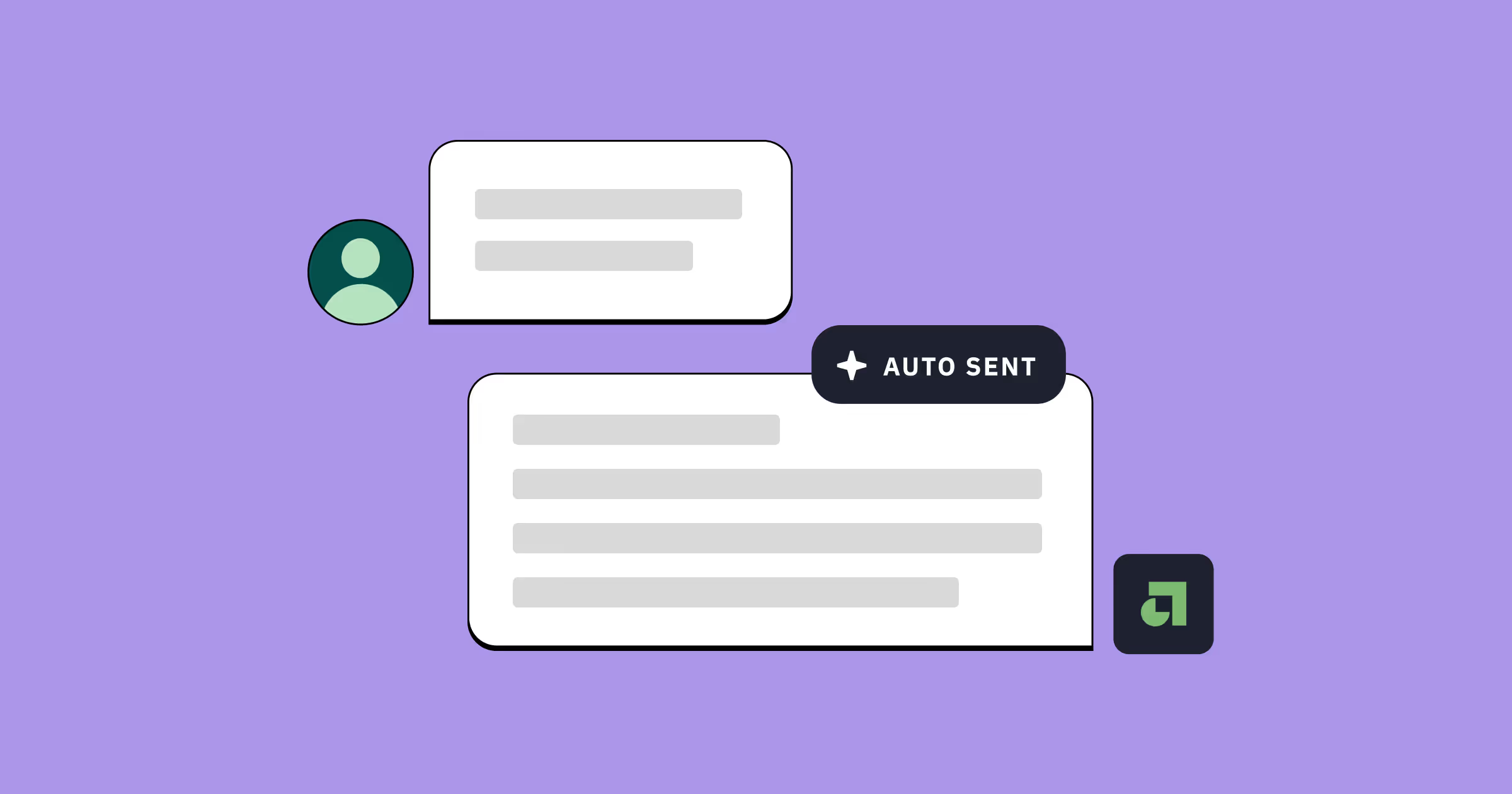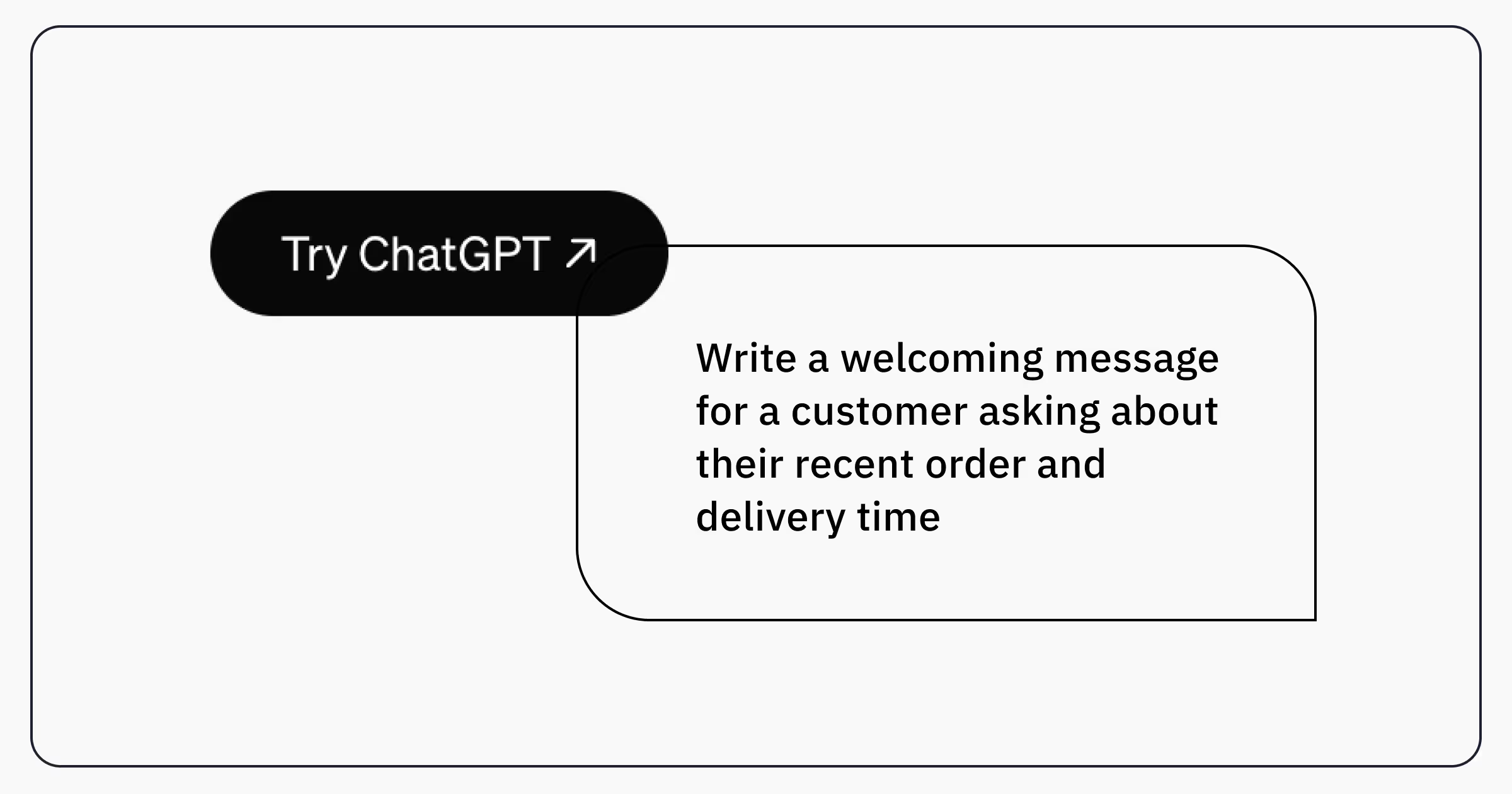Zendesk AI agents: Setup, price, and alternatives

Zendesk claims its AI agents can resolve up to 80% of customer inquiries. But in practice, most teams struggle to reach that benchmark, especially as customer needs grow more complex and support environments more dynamic.
With rising ticket volumes, stretched budgets, and growing expectations, businesses are turning to AI agents to scale operations without sacrificing service quality. Zendesk is one of the most visible options in this space. Its AI agents are tightly integrated into the broader Zendesk CX platform and promise faster resolutions, smarter workflows, and lower costs through automation.
But the reality can vary depending on your team’s needs, support complexity, and operational maturity. For many teams, understanding how these agents are built — and what they can and can’t do — is key to making the right investment. And for hybrid support teams managing complex workflows across channels, newer alternatives like Assembled AI agents may offer a better fit.
What are Zendesk AI agents?
Zendesk AI agents are part of Zendesk’s broader customer support platform, which provides businesses with tools to manage service requests across email, chat, voice, and other channels. Originally known for its help desk and ticketing system, Zendesk has evolved into a full customer experience (CX) suite, with AI now playing a central role in its product strategy.
Zendesk AI agents combine automation and generative AI to help teams:
- Respond to common questions automatically
- Triage and route tickets to the right agents
- Assist agents in writing replies, summarizing conversations, and resolving issues faster
These features are bundled across Zendesk’s automation tools and its agent copilot, and are built using both in-house models and technology from its 2024 acquisition of Ultimate.
In practice, Zendesk AI agents can either handle tickets end-to-end (such as resolving simple refund requests) or support agents behind the scenes with relevant context and suggestions. They’re most effective when paired with Zendesk’s existing workflows, but access, configurability, and performance can vary based on your plan and setup.
Key features and capabilities of Zendesk AI agents
Zendesk AI agents are designed to help support teams resolve issues faster by combining automation, AI-driven triage, and agent assistance tools. These capabilities are bundled under Zendesk’s AI suite, which draws on both in-house technology and features from its acquisition of Ultimate. While feature access depends on your plan and configuration, here are the core capabilities available today:
AI-powered customer interactions
Zendesk AI agents can autonomously handle common customer questions via chat and email, generating replies using a combination of Zendesk’s knowledge base and pretrained large language models. These interactions are most effective for high-volume, low-complexity inquiries, such as order status updates, returns, or password resets. Zendesk emphasizes that these agents are not just designed to deflect, but to provide immediate resolution when possible.
Natural language and sentiment analysis
Zendesk’s AI uses natural language processing (NLP) to detect customer intent, sentiment, and language. This helps classify tickets automatically and inform routing decisions. The platform also includes entity detection — an admin-configured feature that flags keywords or concepts within a ticket to trigger specific actions. While flexible, this is largely rules-based and works best with clearly defined use cases.
Omnichannel support
Zendesk AI agents support multiple communication channels, including chat and email, with automation features extending to SMS and WhatsApp in select configurations. This breadth ensures consistent automation coverage across the customer journey, especially for businesses already using Zendesk’s broader suite. The automation layer (powered by Ultimate) is distinct from Zendesk’s copilot tools, which support agents behind the scenes.
Agent productivity tools
Zendesk’s in-house AI Copilot enhances agent workflows with features like:
- Suggested replies based on past ticket data
- Smart search across knowledge base articles
- Ticket summarization
- Language and tone adjustment
- “Similar tickets” recommendations to reduce repetitive research
These tools are designed to speed up resolution time and reduce manual effort, particularly for newer or less tenured agents. Copilot suggestions are surfaced proactively, but agents retain full control over which ones to use.
Ticket triage and routing
Zendesk AI includes built-in triage capabilities that classify incoming tickets by urgency, sentiment, language, and customer profile (e.g., VIP status). Based on this metadata, the system can automatically assign tickets to the right queue, agent, or workflow. Admins can also set up prediction-based routing using predefined intents or request custom intents from Zendesk’s ML team.
Zendesk AI agents use cases
Zendesk AI agents are best suited for high-volume, low-complexity support scenarios, especially in B2C environments where customers expect instant answers to common questions. By combining generative automation with ticket triage and agent assist tools, Zendesk helps teams reduce manual effort and resolve issues faster.
That said, they’re less effective in complex or high-touch scenarios, where context, nuance, or cross-functional workflows are required.
Here are a few common use cases where Zendesk AI agents are most effective:
Automating common questions and tasks
Zendesk’s generative bots can handle repetitive requests like:
- “Where is my order?”
- “How do I return an item?”
- “What’s your cancellation policy?”
These responses are typically powered by a company’s help center articles and enhanced by Zendesk’s AI suggestions. When configured correctly, the bots can resolve tickets end-to-end, freeing agents to focus on more complex cases.
Deflecting volume during surges
During peak seasons or unexpected spikes in demand, Zendesk AI agents act as the first line of defense. They can absorb incoming volume by responding to simple tickets automatically or routing requests to the appropriate team based on intent and urgency.
This is especially useful for e-commerce, travel, or fintech companies that see dramatic fluctuations in support volume.
Accelerating agent workflows
Even when a ticket requires human attention, Zendesk AI helps speed things up through agent assist features like:
- Suggested replies based on similar past cases
- Auto-filled tags, sentiments, and priority levels
- Ticket summarization for handoffs or escalations
These tools aim to reduce handle time and improve consistency across agents, especially useful for newer team members.
Supporting global teams
Zendesk AI includes features like language detection and multilingual support, which help route tickets appropriately and respond in the customer’s preferred language. Combined with time-based triage and SLA prediction tools, this makes Zendesk a viable option for global, 24/7 teams.
Where friction starts to appear
While Zendesk AI agents perform well in straightforward workflows, challenges tend to emerge in more nuanced or high-variance environments, like B2B SaaS, healthcare, or financial services. In these contexts, automation needs to account for complex business logic, compliance requirements, or intricate handoff scenarios between teams. Zendesk’s tools can be stretched to accommodate some of this, but often require custom workarounds or significant admin overhead.
Zendesk pricing and considerations
Zendesk AI features are primarily available as part of Zendesk’s Suite plans, with availability and access tied to tier level, usage volume, and early access status. While Zendesk markets its AI tools as built-in, the reality is a bit more nuanced, especially for teams exploring automation at scale.
AI is bundled… but fragmented
Zendesk AI agents are included in Suite Professional and Suite Enterprise plans, but not all features are universally available. Some tools, such as AI-powered triage and macros, are built into the platform. Others, such as Zendesk Copilot or advanced generative agents, are either in early access or gated behind add-ons.
Zendesk’s most advanced AI tools, such as Agent Copilot and intelligent triage, typically cost an additional $50 per agent per month and may require a higher-tier plan. Unlocking Zendesk’s full AI potential often means layering on extra spend beyond the base subscription.
Token-based usage and cost complexity
Automation features in Zendesk often run on a token- or resolution-based pricing model, where usage is tied to the volume of AI interactions or successful resolutions. Zendesk doesn’t publicly list per-token costs, and under its outcome-based pricing — introduced in mid-2024 — teams are charged only when an issue is resolved autonomously by AI.
While this model sounds efficient, forecasting usage can be tricky, especially for high-volume teams. Customers have reported unpredictable overage charges, with estimates ranging from $1.50 to $2.00 per AI resolution. Adding to the complexity, Zendesk uses a 72-hour counting window to determine if an issue was resolved, which can make real-time cost tracking difficult. Some users have also raised concerns about inconsistent resolution classification, making it unclear which interactions will actually be billed.
Admin overhead for configuration
While Zendesk AI aims to be easy to use, customizing it to fit your team’s workflows often requires significant admin effort. For example:
- Intent classification may require collaboration with Zendesk’s ML team
- Entity detection must be configured manually
- Routing rules often rely on rigid logic rather than dynamic data inputs
Teams looking for a more flexible, no-code approach may find this limiting, particularly if they lack dedicated technical resources.
Analytics are split across multiple dashboards
Zendesk AI performance metrics are divided across various dashboards depending on the toolset:
- Bot resolution rates and intent classification live in the automation dashboard
- Copilot usage is tracked separately
- Admins may need to pull additional data from Explore or custom reporting
This fragmentation makes it difficult to get a unified view of how AI is impacting both customer outcomes and agent productivity.

Where Zendesk AI agents fall short
Zendesk AI agents offer solid automation and assist tools for straightforward customer service tasks, but when it comes to more complex, nuanced, or high-volume operations, the cracks start to show. These limitations aren’t always obvious in the sales pitch, but they tend to surface quickly in day-to-day operations, especially for support teams dealing with multiple channels, complex business logic, or hybrid agent workflows.
Fragmented backend and tool sprawl
Zendesk’s AI experience is spread across multiple systems. Bots are powered by Ultimate, agent tools are handled separately by Zendesk Copilot, and reporting lives in Explore or additional dashboards. There’s no unified “brain” behind the system — each tool runs its own logic, and orchestration between them often requires manual work or brittle rules.
The result? A disjointed experience where AI-powered automations, agent workflows, and reporting don’t talk to each other in real time.
Limited customization and control
Support leaders often run into walls when trying to tailor Zendesk AI to their team’s workflows. Custom intent models may require hands-on support from Zendesk’s ML team. Entity detection and response tuning must be done manually. And fallback logic — such as when the bot should escalate to a human — is limited to predefined rules.
What’s more, Zendesk AI doesn’t offer much in the way of tone or brand control. You can’t reliably configure the voice, guardrails, or escalation behavior of generative responses. This makes it difficult to ensure quality and consistency across channels, especially for companies in regulated industries or those with strong brand guidelines.
Trust, transparency, and measurement issues
For many teams, one of the biggest challenges with Zendesk AI is understanding what’s working — and what’s not. Since its AI systems are built on multiple platforms, performance data is siloed and hard to correlate. Admins may need to bounce between dashboards to track resolution rates, model accuracy, or escalation trends.
Even more concerning: Zendesk acknowledges hallucinations as an intrinsic risk of its AI, and teams have limited visibility into when and why incorrect or misleading replies are generated. While feedback is monitored, full output traceability isn’t available. There’s also no unified view of how AI and humans interact across the lifecycle of a ticket, making it difficult to optimize, troubleshoot, or build trust in the system.
Better for simple, repetitive interactions
At its core, Zendesk AI is designed to reduce workload on basic, high-volume support requests. That works well for e-commerce returns, order status updates, and password resets. But for more complex use cases — like enterprise B2B support, regulated industries, or cases that span multiple teams — Zendesk’s tools can fall short.
Support teams with variable ticket types, long time-to-resolution, or hybrid agent/bot flows often find themselves building fragile workarounds to get Zendesk AI to behave the way they need.
A better alternative: Assembled AI agents
If Zendesk AI is built to automate common questions, Assembled AI is built to solve real customer issues — efficiently, accurately, and at scale. It’s designed from the ground up to support hybrid agent/AI workflows, high-variance ticket types, and the operational rigor support leaders need to stay in control.
Assembled AI agents go beyond front-line automation. They’re deeply integrated into your team’s tools, workflows, and data, so every interaction is grounded in real context and backed by orchestration logic you can trust.
Here’s how they compare:
Unified by design
Unlike Zendesk’s fragmented stack, Assembled AI agents operate within a single orchestration layer. Whether you're deploying automation across email, chat, or voice, everything — from routing logic to escalation paths to reporting — is coordinated from one place. No bolted-on bots. No siloed dashboards. Just a clear, connected system that makes hybrid teams more efficient.
Built for real resolution
Assembled AI agents are trained not just to respond, but to resolve. That means:
- Pulling in real-time data from tools like Shopify, Salesforce, and internal APIs
- Updating systems and records automatically (not just linking help docs)
- Recognizing when to escalate and handing off with full context intact
Where Zendesk AI often deflects or stalls on complex cases, Assembled AI is designed to complete the task, or seamlessly hand it off to a human with everything they need to finish the job.
Agent copilots with context
Assembled’s agent assist tools go beyond basic reply suggestions. Every AI-recommended action is grounded in the specific customer context, relevant policies, and past resolution history. Agents can:
- Auto-summarize complex conversations
- See next-best actions based on similar cases
- Get pre-drafted replies aligned to your brand voice and business rules
And because Assembled’s agent copilot is orchestrated alongside the automation layer, agents and AI aren’t working in parallel — they’re working in sync.
Transparent by default
Support leaders deserve to know what’s happening behind the scenes. That’s why Assembled AI is built with traceability, audit logs, and confidence scoring at the core. You can:
- See which automations fired and why
- Review AI responses and override logic when needed
- Measure performance across channels in a single dashboard
This transparency not only builds trust — it gives you the control you need to improve over time.
See the real impact — across AI and humans
Assembled doesn’t just tell you what your AI agents are doing — it shows how that work changes the shape of your entire team. With purpose-built reporting, you can see how AI is impacting handle time, CSAT, and agent productivity across every channel and queue.
More importantly, it goes beyond performance metrics to inform real-world decisions about staffing and scheduling. You’ll get visibility into:
- How many cases are being automated (and where)
- How AI is changing your headcount needs by channel, queue, or shift
- How to adjust forecasts based on automation patterns and performance
Because Assembled is a WFM platform at its core, you can tie AI outcomes directly to workforce planning — not just tickets resolved. That means smarter resourcing decisions, fewer surprises, and automation strategies grounded in operational reality.
Easy to configure. Powerful to scale.
Assembled AI doesn’t require months of implementation or a team of ML engineers. Admins can:
- Launch new intents in minutes (no training cycles)
- Control fallbacks, tone, and escalation behavior
- Adjust logic in plain language or JSON
It’s fast to get started — and even faster to evolve as your business grows.
Dynamically adaptive, not rigidly rules-based
Where Zendesk relies on brittle, rules-based automation and static fallback logic, Assembled gives support teams real-time flexibility through dynamic handoffs. You can configure thresholds — like when SLA performance drops below target — that automatically adjust how many tickets are routed to AI versus humans.
That means you’re not stuck choosing between full automation or full manual handling. When pressure spikes, Assembled shifts more volume to automation to protect agent workload and maintain service levels. And because these decisions are powered by live WFM data — not just static rules — they reflect what’s actually happening in your support environment.
While Zendesk could theoretically support this through its 2023 acquisition of Tymeshift (now Zendesk WFM), AI-WFM coordination like this isn’t offered out of the box. Assembled builds it in by default — because sustainable automation starts with the humans it’s meant to support.
Zendesk AI agents vs. Assembled AI agents
Want a side-by-side look? Here's how Zendesk AI agents stack up against Assembled AI agents.

Unlock smarter AI-driven support with Assembled AI
Zendesk AI agents are fine if you're staying within a traditional help desk. But when your team needs resolution across channels, coordinated agent/AI workflows, and full visibility into what's working, those limits add up.
Assembled AI agents were built for modern support. They work across your entire stack. They adapt to fast-changing operations. And they give support leaders the control and clarity they’ve been missing.
Curious how your team could benefit from smarter orchestration and full AI-agent coordination? Book a personalized demo to see Assembled in action.




_%20Improve%20CX%20%26%20cut%20costs.avif)